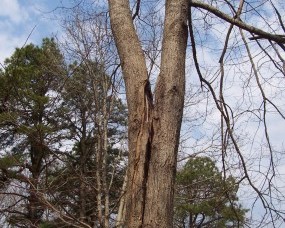Storm Damaged Repair and Tree Removal
After tornadoes and microburst storms, a major cause of property damage and power outages is, of course tree failure. Falling tree limbs and trees uprooted from high winds or an ice storm can put your property and personal safety a in potential jeopardy.
Have your trees inspected yearly
Some tree defects can be corrected through pruning and some defects may warrant having the tree removed. In tree risk assessment, there are many factors an arborist considers in predicting the future out come of a tree. There are however some basic leading factors that anyone can learn to recognize.
Deadwood and Die-back in crown
Most often deadwood can be pruned out of a tree to make it safe. In some cases, however there may be significant enough dieback in a tree to indicate the declining health and stability of the tree.
Take immediate action if…
-
- A broken branch or top is lodged in a tree.
- A tree is dead.
- A branch is dead and of sufficient size to cause injury (this will vary with height and size of branch).
Cracks in stem of tree
If you see any cracks in tree limbs or in the main stem of your tree, this could be a serious hazard. Cracked limbs may be pruned out while cracked trunks will most likely require a complete tree removal.
Take action if…
- A crack extends deeply into, or completely through the stem.
- Two or more cracks occur in the same general area of the stem.
- A crack is in contact with another defect.
- A branch of sufficient size to cause injury is cracked.
Keep in mind that a visually detectable crack indicates that the tree is already failing to some degree!
Week branch unions and Co-dominant stems

Weak branch union can often be supported by a supplemental support installed in the tree’s canopy. Tree cabling and bracing, if installed properly, can be very effective in mitigating the hazards posed by Co-dominant stems or weal branch unions.
Take action if…
- A weak branch union occurs on the main stem.
- A weak branch union is cracked.
- A weak branch union is associated with a crack, cavity, or other defect.
Cavities and cankers in stem

- A cavity or multiple cankers affect more than half of the tree’s circumference.
- A cavity is physically connected to a crack, weak branch union, or other defect.
Signs of decay in stem or roots

If you see any of these symptoms in your tree you should contact a professional arborist to help you assess the health and condition of your tree.
Take action if…
- Advanced decay is associated with cracks, weak branch unions, or other defects.
- A branch of sufficient size to cause injury is decayed.
- The thickness of sound wood is less than 1″ for every 6″ of diameter at any point on the stem.

Insect damage

In this picture, Pine Bark beetles, a common pest, have riddled the trunk with holes. Pine trees infected with these Pine beetles will often die completely within 2-3 years.
Again, a proper tree risk assessment requires thorough investigation of many factors. But looking for these basic tree defects can give you a good initial idea of the health and stability of your trees. Trees, by their nature and design are quite capable of withstanding, even very strong storms and winds. But trees do fail, and have an even greater likely hood of failure when weakened by one or more of these defects.






